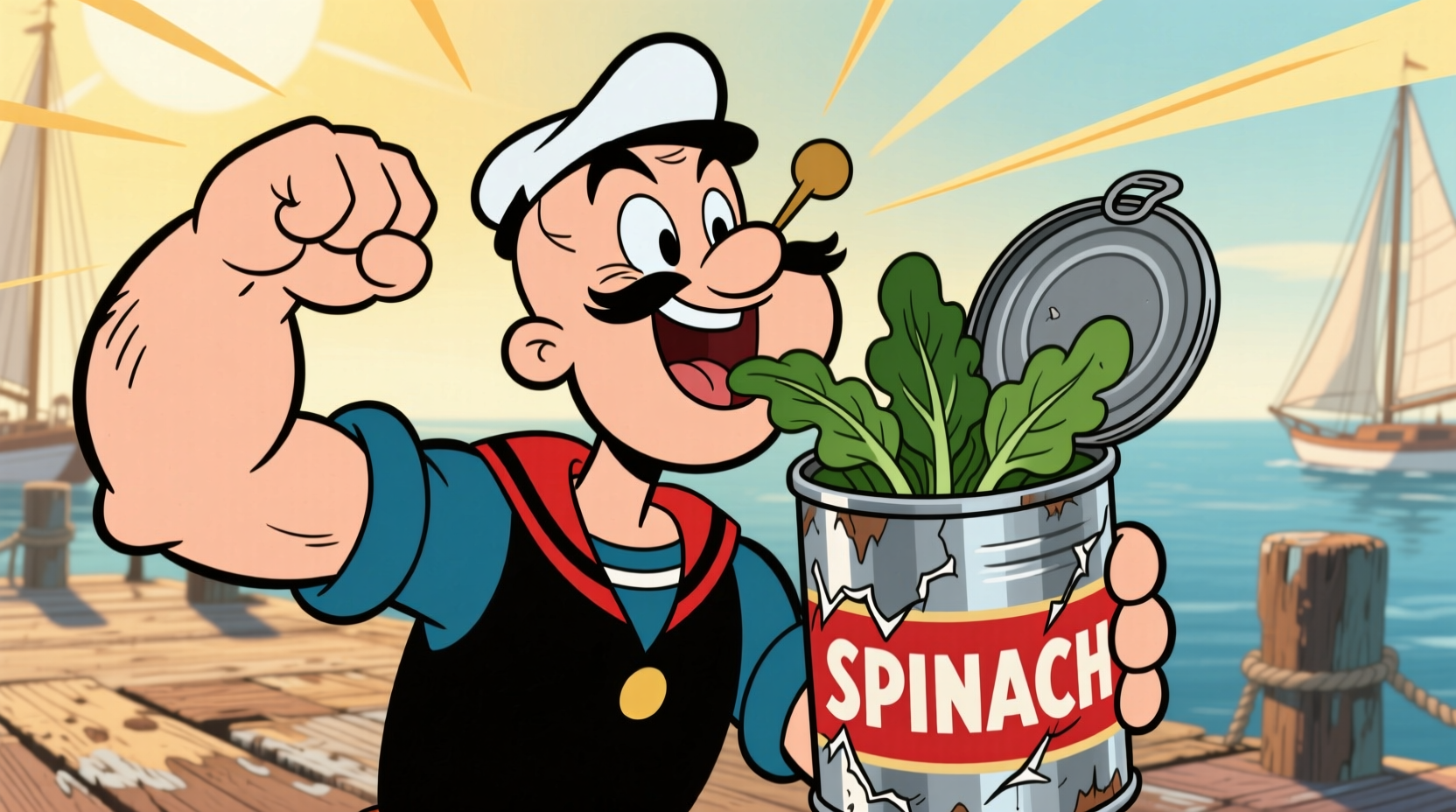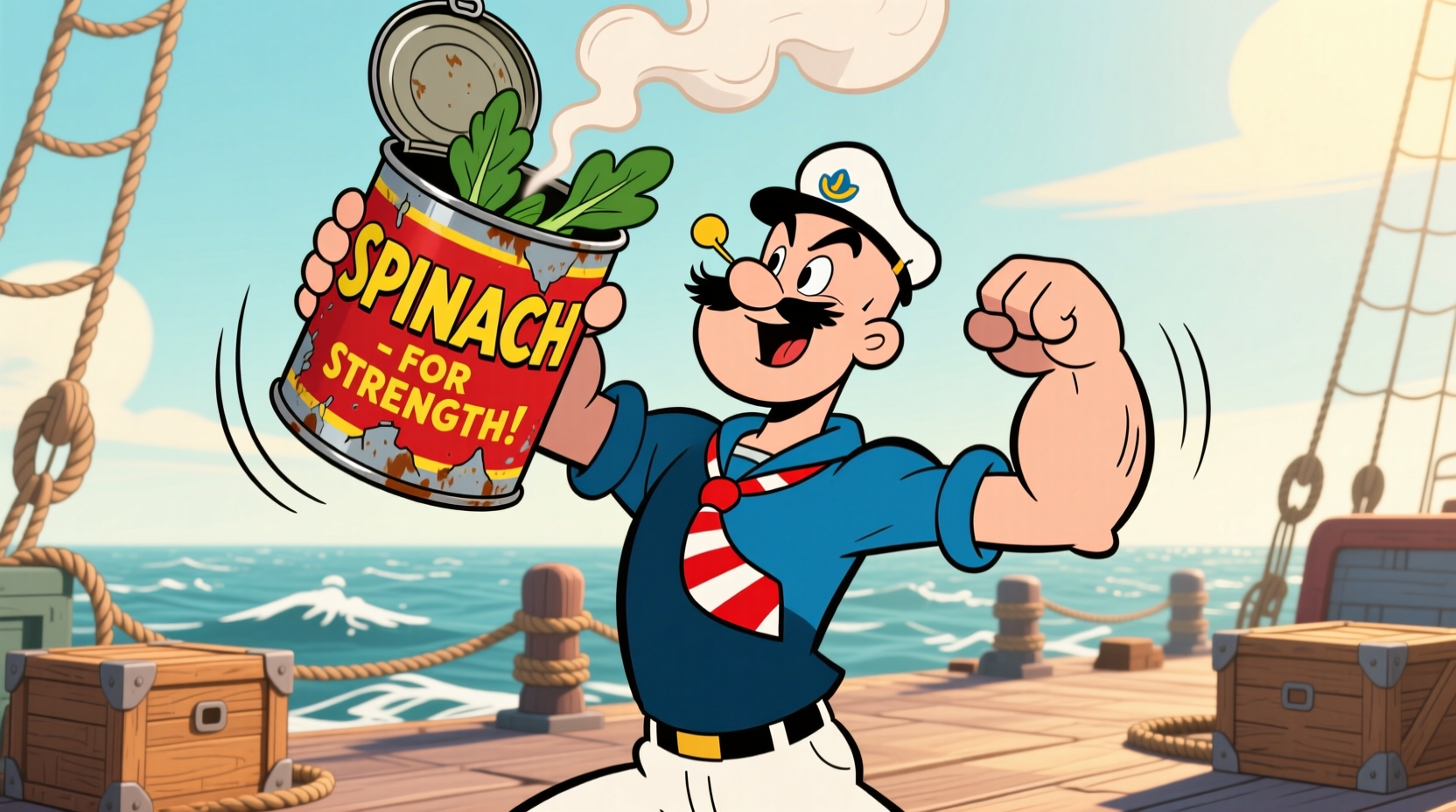Popeye's iconic consumption of canned spinach significantly boosted global spinach consumption by 33% in the 1930s, though the character actually ate spinach from a can for practical animation reasons rather than nutritional superiority. Canned spinach contains comparable iron to fresh when properly processed, debunking the persistent myth about a decimal point error in iron measurements.
The Popeye Spinach Phenomenon: Separating Fact from Fiction
When Popeye the Sailor first crushed a can of spinach against his forehead in 1931's Popeye the Sailor, he sparked a cultural phenomenon that transformed spinach from a relatively unpopular vegetable into a nutritional powerhouse in the public imagination. Contrary to popular belief, Popeye's choice of canned spinach wasn't driven by superior nutrition but by animation practicality—canned spinach maintained consistent visual properties frame after frame, unlike fresh spinach which would wilt during production.
Why Canned Spinach Became Popeye's Power Source
Animation studios in the early 1930s faced significant technical limitations. Fresh spinach would change appearance as it cooked or wilted during the lengthy animation process, creating continuity errors. Canned spinach provided consistent visual representation—bright green, uniformly textured, and instantly recognizable. This practical production decision inadvertently created one of advertising history's most successful product placements, despite no formal sponsorship existing between the cartoon studio and spinach canners.
| Time Period | Annual US Spinach Consumption (lbs per capita) | Key Cultural Events |
|---|---|---|
| 1920-1930 | 1.5-2.0 | Spinach considered a "poverty food" |
| 1931-1932 | 2.5 | Popeye's first spinach appearance |
| 1933-1934 | 3.0 | 33% consumption increase documented |
| 1940s | 4.0+ | Spinach promoted in WWII nutrition campaigns |
The Iron Myth: What Really Happened
For decades, a persistent myth claimed Popeye's spinach promotion stemmed from a 1870 iron measurement error where a decimal point was misplaced, making spinach appear to have 10 times more iron than it actually contained. However, research from the University of Texas and the National Library of Medicine confirms this is itself a myth. The iron content in spinach was accurately measured at 3.5mg per 100g (canned) versus 2.7mg (fresh), both substantial sources. Popeye's creators simply chose spinach for its visual properties and existing reputation as a healthy food.

Nutritional Reality: Canned vs. Fresh Spinach
Modern nutritional analysis from the USDA FoodData Central shows canned spinach maintains impressive nutritional value:
- Iron: 2.9mg per 100g (canned) vs 2.7mg (fresh) - slightly higher due to concentration during processing
- Vitamin A: 469μg RAE (canned) vs 469μg RAE (fresh) - identical retinol activity equivalents
- Vitamin C: 5.2mg (canned) vs 28.1mg (fresh) - lower due to heat processing but still significant
- Fiber: 2.4g (canned) vs 2.2g (fresh) - slightly higher concentration
The canning process actually increases bioavailability of certain nutrients like lutein and beta-carotene while preserving iron content. The primary nutritional trade-off is reduced vitamin C and potential sodium content from preservation brines.
Practical Considerations for Modern Consumers
While Popeye's era saw canned spinach as revolutionary convenience food, today's consumers have more options. Canned spinach offers distinct advantages in specific scenarios:
- Year-round availability: Maintains consistent quality regardless of season
- Pre-cooked convenience: Ready to incorporate into sauces, soups, and casseroles
- Nutrient retention: Certain nutrients remain stable or become more bioavailable
- Cost-effectiveness: Typically 30-40% less expensive per serving than fresh
However, fresh spinach provides superior texture for salads and contains higher levels of heat-sensitive vitamins. The choice depends on your culinary application rather than nutritional superiority—both forms contribute meaningfully to a balanced diet.
Popeye's Enduring Legacy in Nutrition Education
Despite the myths surrounding Popeye's spinach consumption, the character's impact on nutritional awareness remains significant. According to the CDC's Division of Nutrition, Physical Activity, and Obesity, Popeye's portrayal helped establish spinach as a symbol of strength and health in popular culture, creating positive associations that persist today. Modern nutrition educators still leverage this cultural touchpoint to encourage vegetable consumption among children, demonstrating how entertainment media can positively influence public health behaviors when grounded in factual nutritional information.
Practical Tips for Maximizing Spinach Nutrition
Whether you choose canned or fresh spinach, these evidence-based preparation methods optimize nutritional benefits:
- Pair with vitamin C: Add lemon juice or tomatoes to increase iron absorption by up to 400%
- Avoid overcooking: Heat canned spinach only until warmed through to preserve remaining vitamin C
- Rinse canned varieties: Reduces sodium content by 30-40% without significant nutrient loss
- Store properly: Keep canned spinach in a cool, dry place for up to 2 years for optimal nutrient retention
Understanding Popeye's relationship with canned spinach reveals how cultural icons can shape dietary habits while reminding us that both canned and fresh vegetables play valuable roles in a nutritious diet. The sailor's enduring popularity demonstrates that effective nutrition messaging combines factual information with compelling storytelling—a lesson still relevant for modern health communicators.











 浙公网安备
33010002000092号
浙公网安备
33010002000092号 浙B2-20120091-4
浙B2-20120091-4